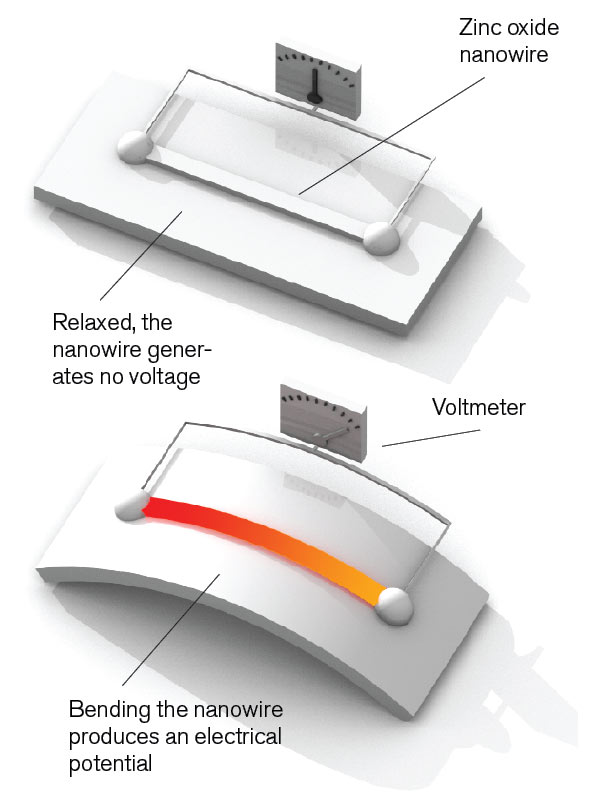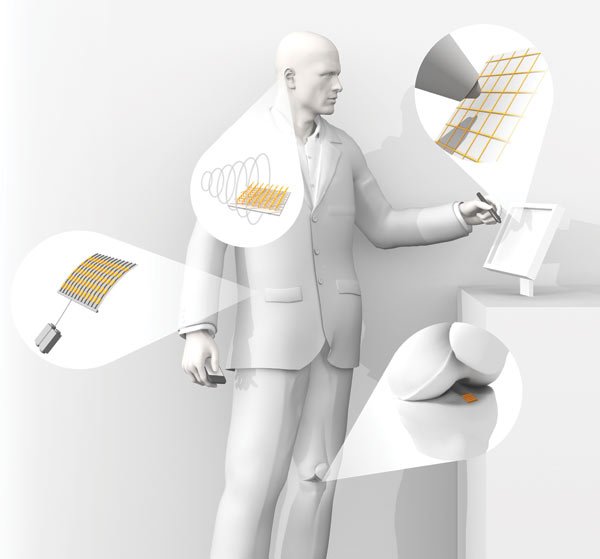Nanopiezoelectronics

Nanoscale sensors are exquisitely sensitive, very frugal with power, and, of course, tiny. They could be useful in detecting molecular signs of disease in the blood, minute amounts of poisonous gases in the air, and trace contaminants in food. But the batteries and integrated circuits necessary to drive these devices make them difficult to fully miniaturize. The goal of Zhong Lin Wang, a materials scientist at Georgia Tech, is to bring power to the nano world with minuscule generators that take advantage of piezoelectricity. If he succeeds, biological and chemical nano sensors will be able to power themselves.
The piezoelectric effect–in which crystalline materials under mechanical stress produce an electrical potential–has been known of for more than a century. But in 2005, Wang was the first to demonstrate it at the nanoscale by bending zinc oxide nanowires with the probe of an atomic-force microscope. As the wires flex and return to their original shape, the potential produced by the zinc and oxide ions drives an electrical current. The current that Wang coaxed from the wires in his initial experiments was tiny; the electrical potential peaked at a few millivolts. But Wang rightly suspected that with enough engineering, he could design a practical nanoscale power source by harnessing the tiny vibrations all around us–sound waves, the wind, even the turbulence of blood flow over an implanted device. These subtle movements would bend nanowires, generating electricity.

Last November, Wang embedded zinc oxide nanowires in a layer of polymer; the resulting sheets put out 50 millivolts when flexed. This is a major step forward in powering tiny sensors.
And Wang hopes that these generators could eventually be woven into fabric; the rustling of a shirt could generate enough power to charge the batteries of devices like iPods. For now, the nanogenerator’s output is too low for that. “We need to get to 200 millivolts or more,” says Wang. He’ll get there by layering the wires, he says, though it might take five to ten more years of careful engineering.
Meanwhile, Wang has demonstrated the first components for a new class of nanoscale sensors. Nanopiezotronics, as he calls this technology, exploit the fact that zinc oxide nanowires not only exhibit the piezoelectric effect but are semiconductors. The first property lets them act as mechanical sensors, because they produce an electrical response to mechanical stress. The second means that they can be used to make the basic components of integrated circuits, including transistors and diodes. Unlike traditional electronic components, nanopiezotronics don’t need an external source of electricity. They generate their own when exposed to the same kinds of mechanical stresses that power nanogenerators.

Freeing nanoelectronics from outside power sources opens up all sorts of possibilities. A nanopiezotronic hearing aid integrated with a nanogenerator might use an array of nanowires, each tuned to vibrate at a different frequency over a large range of sounds. The nanowires would convert sounds into electrical signals and process them so that they could be conveyed directly to neurons in the brain. Not only would such implanted neural prosthetics be more compact and more sensitive than traditional hearing aids, but they wouldn’t need to be removed so their batteries could be changed. Nanopiezotronic sensors might also be used to detect mechanical stresses in an airplane engine; just a few nanowire components could monitor stress, process the information, and then communicate the relevant data to an airplane’s computer. Whether in the body or in the air, nano devices would at last be set loose in the world all around us.
Keep Reading
Most Popular
Large language models can do jaw-dropping things. But nobody knows exactly why.
And that's a problem. Figuring it out is one of the biggest scientific puzzles of our time and a crucial step towards controlling more powerful future models.
How scientists traced a mysterious covid case back to six toilets
When wastewater surveillance turns into a hunt for a single infected individual, the ethics get tricky.
The problem with plug-in hybrids? Their drivers.
Plug-in hybrids are often sold as a transition to EVs, but new data from Europe shows we’re still underestimating the emissions they produce.
Google DeepMind’s new generative model makes Super Mario–like games from scratch
Genie learns how to control games by watching hours and hours of video. It could help train next-gen robots too.
Stay connected
Get the latest updates from
MIT Technology Review
Discover special offers, top stories, upcoming events, and more.